
South L.A. Wetlands Park in South L.A. Photo by Brenda Verano
A multi-million grant could soon help beautify, remodel and transform a park located in the heart of South Central Los Angeles, a community with one of the most extreme dearth of parks and green spaces in L.A. County.
Earlier this week, L.A. City Councilmember Curren Price, who represents the city’s 9th Council District, announced that his office had applied and successfully secured a $4.2 million Measure A grant for the South L.A. Wetlands Park, a park that, according to community members and park advocates, has been neglected and overlooked in the last few years.
Today, in the wake of the multi-million dollar investment that is to come, community members from South L.A. demand that the funds be invested transparently and that the community have a direct say on how the funds will be used. They also ask for the organizing efforts of community members who have been advocating for better park amenities and improvements to be recognized.
“We are at a point now where the community is already fed up with the years of negligence,” Oscar Aguayo, a community member and park goer, told CALÒ News. “We wanted to see this green space utilized better for the community. The current conditions are not something that we are going to stand with anymore. This is a park for the community; we deserve to know where the money is going to go. Who will it go to? What things will this money help fund and will they bring outside organizations or other outsiders to do the job?”
“Despite the safety hazards and issues affecting the park, this is still a very special place for elders and señoras or señores who, like my parents, use this park constantly,” Aguayo said.
The park, which sits on 54th St., between Avalon Blvd. and San Pedro St., one of the most populated areas of CD-9, opened in 2012 after a $26 million renovation that transformed an underutilized bus maintenance and rail yard into the park.
When it opened, the park, constructed with Proposition O funding, which supported public health and the fulfillment of Federal Clean Water Act requirements, looked to be an environmental justice initiative and a neighborhood-rejuvenating amenity in a historically underserved community, but today, many community members say this is no longer the case.

The empty and abandoned building at the site. Photo by Brenda Verano
“ The park is a highly trafficked space. I think for many years now, folks have been using it as one of the few spaces that we have access to for physical activity. Community, grassroots groups have emerged and I think that's fantastic to get folks talking about what's needed in the space because, reflecting back, there was so much promise around the park,” Azusena Favela, vice president of the Zapata King Neighborhood Council, one of the neighborhood councils within CD-9, told CALÒ News on Wednesday.
Favela also said the $4.2 million grant will be rolling out in phases.
Park deserts, such as South Central Los Angeles, can have disastrous effects on local residents as well as wildlife. The South Central L.A. landscape, which is often characterized by an overconcentration of liquor stores and a lack of quality, affordable grocery stores and sit-down restaurants, contributes to high rates of heart disease, diabetes and premature death among South L.A. residents. The closest park to the South Los Angeles Wetlands Park with another body of water is the Augustus F. Hawkins Nature Park, 1.4 miles away.
According to the Prevention Institute, in partnership with UCLA, the National Health Foundation, Community Coalition, Esperanza Community Housing Corporation and the Social Justice Learning Institute, the relationship between access to parkland and life expectancy is closely linked.
According to the research, South Central L.A. is considered to have ‘high park need’ and ‘very high park need’ neighborhoods, with an average of 1.6 and 0.7 acres of parkland per 1,000 residents, in comparison to the L.A. Countywide average, which is 3.3 acres of parkland per 1,000 residents. The median life expectancy in South L.A. is 77 years, well below the upper bound for the county as a whole. About 15 miles away in the community of Beverly Hills, the life expectancy is about 90 years, 13 years higher.
Despite still being one of the only parks within walking distance for many South L.A. residents, Aguayo said the park's safety and care have been declining. “In the winter, it was completely dark by 5 p.m., and I remember in December there were only one or two lights in the whole park that worked. It was very frustrating because there's a lot of community members that stop running because they do not feel safe,” Aguayo said.
In September 2024, the Central Alameda Neighborhood Council, another one of the neighborhood councils within CD-9, wrote a letter to Mayor Karen Bass, outlining many of the community’s urgent concerns and emphasizing the need for a community-driven approach to restoring and investing in the park. Some of the concerns included poor lighting, unsanitary restrooms, a lack of handwashing stations, increasing reports of rodent infestations and concern about an empty warehouse inside the park, which in the last year has caught fire many times.

The empty and abandoned building at the site has caught fire many times. Photo by Brenda Verano
The park opened nearly 13 years ago, but there are no indoor restrooms, apart from two porta potties placed in front of the park and one in the back of the park. “It’s been years and the park still has no real restrooms. We have porta potties that are filthy, and there's no consistency in being able to clean them up,” Vasquez said.
Adriana Cabrera, president of the Central Alameda Neighborhood Council and principal author of the letter, which asked that the mayor's office work with Price and the Department of Recreation and Parks to establish a South L.A. Wetlands revitalization committee with local residents. “As the neighborhood council, our job is to be the bridge between our city leaders and the community,” she said. “The park is very special to me and I think we all want the park to be the best it can be.”
Cabrera, who was born and raised in South L.A., and who in 2022 ran against Price for the CD-9 council seat, said she wrote the letter to Bass after community members who had begun organizing around the park's needs alleged that they needed support in bringing their concerns to city leaders.
One of the residents and community members is Victor Vasquez, who lives a couple of minutes away from the park and who, in June, three months before the letter was sent to Bass, began an online petition asking CD-9 to install proper restrooms at South LA Wetlands Park.
Vasquez said his parents, who are now retired, go to the park multiple times a week for their walks.
Vasquez said that throughout the years, they have reached out to Price’s office to complain about the park’s conditions, but felt like their concerns kept being dismissed.
A spokesperson from Bass's office told CALÒ News that the mayor's staff “has been engaged with the community.”
“Every time the media writes an article about the park and this issue, they respond to us; they say they acknowledge our concerns. They start cleaning the porta potties and the park seems clean for a couple of days, but then everything returns to normal and no real solutions have been presented,” Vasquez told CALÒ News. “Why did it take for us to create a petition, to rally, for them to acknowledge us?”
Regarding the $4.2 million grant for the park, Vasquez credits the South L.A. residents for their “relentless drive to transform South L.A. Wetlands Park,” and said he is happy to hear the funds are coming.
“For far too long, our park has been plagued by inadequate restrooms, a body of water that dries up each summer, pitch-black nights due to poor lighting, a glaring absence of visible security, and an abandoned building that has brought nothing but problems to our community. Now, a tide of change is rising,” he said. “Councilmember Curren Price, we urge you to stand with these tireless organizers. Recognize the vital work they’ve done for our community and act decisively to address these critical issues. Your leadership is essential to ensure our park finally receives the improvements it deserves. Together, our powerful voices will forge a brighter, safer future for all.”

Despite the park's shortcomings, it is also home to ducks, turtles, pollinators, rabbits and other wildlife. Photo by Brenda Verano
Six days after CALÓ News began reaching out to Price's officefor this story, Price announced the $4.2 million grant. “Looking ahead, a $4.2 million Measure A grant, which my office helped secure, will fund a comprehensive master plan, bringing much-needed upgrades, including permanent restrooms and the revitalization of the historic bus yard,” Price told CALÒ News. “This process, guided by the City’s Parks Department, will be shaped by community input to ensure the park reflects the needs of those who use it most.”
Price said community meetings will be held in the coming months to gather ideas and feedback for how the funds could be used. “This park belongs to the people, and your voice is essential in shaping its future. Together, we can protect and enhance this vital neighborhood treasure for generations to come."
Price also commented on the safety of the park and the still ongoing concerns of the park’s amenities. He told CALÒ News that the office has increased security measures, adjusted park hours, implemented daily restroom cleanings, and invested $150,000 in upgraded lighting. “A dedicated security team now monitors the park nightly to ensure a safe environment,” he said.
But Vasquez and Aguayo said they had not seen any security. “I haven't seen one security [person]. I've only seen one person who opens up the gate, leaves and at the end of the day, closes the gate door and leaves again,” Aguayo said.

The park has no indoor restrooms, apart from two porta potties placed in front of the park and one in the back of the park. Photo by Brenda Verano
According to Price, his office has also allocated over $400,000 to repair the voltage cabinet that powers the water fountain in the park, with work expected to be completed by April.
One of the things that the community hopes the grant helps to fund and renovate is the empty and abandoned building at the site.
When I visited the park in late February, chemical-like smells emanated from the building, as if something had just finished burning.
“Individuals have realized that this is an abandoned, unsecured building. So they bring huge loads of copper wiring and break it down in order to be able to sell it. It's the plastic that conserves the copper that runners and elders who run in the park are smelling. Once you go inside the building, you just see a bunch of plastic burning just everywhere,” Vasquez said. “The building has caught on fire so many times and it's making South L.A.’s air quality even worse than it already is.”
As initially reported by the Los Angeles Public Press, the building was at some point going to be used by the Los Angeles County Museum of Art (LACMA). In 2018, the L.A. City Council approved a 35-year lease with LACMA for the use of the building. “Under the lease’s terms, LACMA would repair and retrofit the building at no cost to the L.A. City Department of Recreation and Parks,” the L.A. Press reported. “LACMA ended up ‘pulling out’ of their agreement, according to Price’s office, who declined to provide more information.”
A wellness center for elders, a gym, a daycare facility or an innovation center for youth and people with small businesses are just some ideas that Aguayo has in mind in terms of how the space would be used. “There’s so much talent in South Central. We all just want to be as excited about the park as we once were,” he said.
For Vasquez, more than just beautifying the park, he hopes the grant money helps bring employment opportunities for local businesses and residents. “I hope it is people from our communities who are contracted for the work that has to be done,” he said. “And if the building is occupied by organizations, I hope they are local and that they serve the specific needs of South Central residents.”

The park's porta potty early in the morning. Photo by Brenda Verano
Cabrera said she is optimistic when it comes to the park's future but knows that the new funding is just one part of the solution. “The root of how we got here is the neglect, the lack of accountability for the space and the city services,” she said. “The city and city council, they're not connected to the community, and this is a great opportunity to truly connect with them, because we can fix the lights and fix the building. But the community needs to be connected without leaders. I can tell you that the whole city is not used to being accountable for the inside of town; that needs to change.”
Favela also agrees on the importance of building a stronger foundation for the park, which can be made up of community members and city leaders. “It's a unique time given that community groups are organized and motivated,” she said. “There's $4. 2 million on the table and a [CD-9] upcoming election in two years. It's almost like the perfect storm to benefit the park and to create new partnership opportunities where maybe they just haven't existed in the past.”
On Tuesday, a day after the grant announcement by Price’s office, Cabrera sent another letter to Bass and Price and the Department of Recreation and Parks congratulating them for obtaining the grant. More importantly, the letter also advocated for the creation of a community-led advisory committee for public meetings that could outline a collaborative and transparent process between the city and local residents when it comes to the allocation of funds.
Favela said that although the park officially falls under the Zapata King Neighborhood Council, the fight for the park is rooted beyond neighborhood council lines. “Given the limited park space in our district, it makes absolute sense that more neighborhood councils have an interest and express their voice around the [park] because many of us frequent the space from across the district,“ she said.
“The South Los Angeles Wetlands Park is a cherished community gem, and we are dedicated to preserving and enhancing it for all who visit,” Price told CALÒ News.
Despite the park's shortcomings, it continues to be used by hundreds, if not thousands, of people weekly. It is also home to ducks, turtles, pollinators, rabbits and other wildlife.

The park sits on 54th St., between Avalon Blvd. and San Pedro St., one of the most populated areas of CD-9, . Photo by Brenda Verano
“ $4.2 million sounds like a lot of money, but when we're talking about a space like the wetlands and the amount of work that it needs, given the abandoned building and the levels of toxicity in the space, it's going to require a lot more funding than that,” Fevela said. “What would be helpful is just clarity on the uses, clarity on a timeline and then a system of accountability that's created for community residents to be able to engage and participate in the process.”
Vasquez said despite the upcoming funds, community members are not waiting around for city leadership when it comes to the park's needs. This past weekend, with donated time and effort, Vasquez, along with other parkgoers and community groups, installed a new dog waste station inside the park.
This is a developing story and CALÒ News will follow it closely in the coming months.

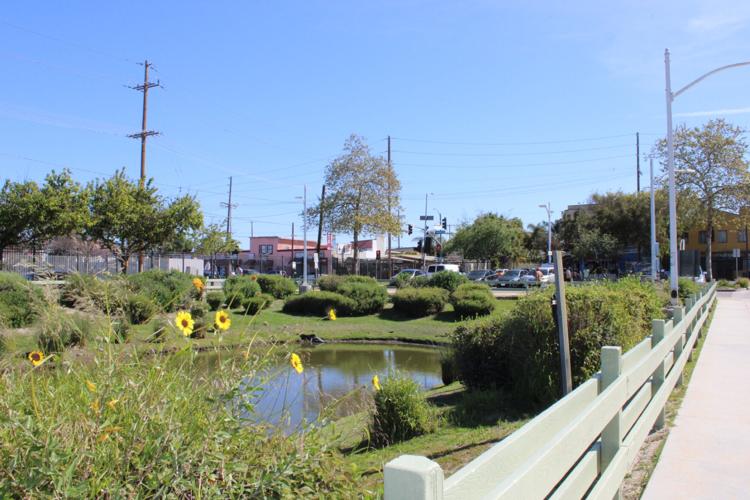
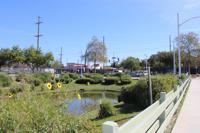

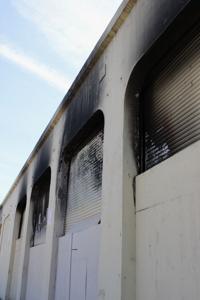





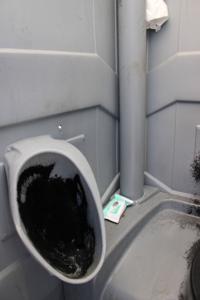

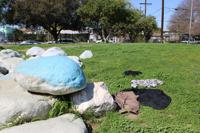






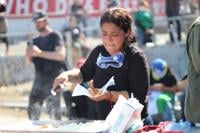


(0) comments
Welcome to the discussion.
Log In
Keep it Clean. Please avoid obscene, vulgar, lewd, racist or sexually-oriented language.
PLEASE TURN OFF YOUR CAPS LOCK.
Don't Threaten. Threats of harming another person will not be tolerated.
Be Truthful. Don't knowingly lie about anyone or anything.
Be Nice. No racism, sexism or any sort of -ism that is degrading to another person.
Be Proactive. Use the 'Report' link on each comment to let us know of abusive posts.
Share with Us. We'd love to hear eyewitness accounts, the history behind an article.